
Quarry Bank Fishery - Part 10
Fennel continues his 12-part series about fishing at the fabulous Quarry Bank Fishery in France, this time digging deep to catch the big carp.
Digging deep
The “natural tension between the elements of air and water”, as mentioned in the last blog, creates more than just a meniscus for pond skaters to do their thing. It’s a force of separation that prefers to keep things apart. However, with the right effort, it can be broken. Kingfishers and herons know this as they plunge into the mirror that separates two worlds. The carp of Quarry Bank knew it too, as they leapt from the water to clean their gills and flanks, and the catfish knew it as they slapped their tails on the surface to stun their prey. Did Shaun, Tim and I know it? I’d like to think so, though our catches would indicate that we were struggling to break the deadlock between anglers and the big fish of Quarry Bank.
Looking out across the quarry pool, I felt entirely in tune with the wildlife around it. But not within it. The fish – as we’d expected them to behave on a full moon – were proving difficult to catch. They knew we were there and, as much as we tried to blend into our surroundings, I’m sure they saw us not as strangely attired waterfowl, rather as overly buoyant yellow plastic ducks whose jolly smiles concealed our lack of legs. Without the paddles needed for us to properly explore the surface and depths of the water, we would have to bob and drift on the ripples until the fish came to us. Or would we? Perhaps we needed to make ‘the right effort’?
‘Going with the flow’ is fine when seeking to connect with the natural rhythms of life and while slowing down on holiday, but angling is a proactive act. It’s a form of hunting. If one fails to catch then one senses the commiserations or mockery of one’s primeval ancestors. They had to hunt to survive; we hunt for recreation knowing that we’re never far from a fridge full of sausages. But the sense of failure remains if we’re outsmarted by a gummy-lipped, cold-blooded, slimy, vacant-looking and gormlessly gawping creature from the depths whose brain is smaller than the rubber on the end of an academic’s pencil.
As Shaun and Tim arrived in the pagoda, looking like they needed lunch, we spoke of our efforts and achievements to date. Each of us knew that we needed to try harder if we were to catch the bigger carp at Quarry Bank.
“So,” said Shaun, “let’s take stock. Fennel, you’ve caught one and lost one.”
“Yes,” I replied, knowing that I had to take responsibility for the fish that slipped the hook while Shaun was playing it on my rod.
“Tim,” said Shaun, “you’ve had two runs; hooked two, lost two.”
“Possibly,” said Tim, knowing that his distant ancestor ‘Grandpa Ug’ was tutting and waving a half-eaten bone at him.
“And I’ve had a drop-back that resulted in nothing,” said Shaun.
“Hmmm,” I replied, “it doesn’t sound that impressive, does it?”
“Perhaps we could include our sausage count?” said Tim.
“So,” said Neil, “you’d like me to enter ‘six dozen sausages’ in your catch return?”
“And a small piccalilli,” I said.
“Don’t forget the crusty roll,” said Shaun.
“And the most impressive lardon,” said Tim.
“Let me get this right,” said Neil. “Your record for the week should read: one carp, a bream, some roach, perch, pike, six dozen sausages, a small piccalilli, a crusty roll, and a most impressive lardon?”
“Yup,” we replied, knowing that we could never admit to the shame of eating lettuce on the second night.
“You men,” said Lin, “you’re always measuring things. Whichever way you look at it, your list is not getting any longer. You’ve only caught one carp.”
Lin was right. We were on a carp fishing holiday and, three nights in, had only one carp to show for our efforts.
Like the quarrymen of old, we would need to dig deep and test our resolve if we were to see what the lake and we were made of.
“Blast it!” I said.
“Eh?!” said Neil, with a look of horror.
“No, no, sorry; I just realised that I was supposed to be cooking lunch.”
Tim and Shaun looked at me, raised their eyebrows, and nodded.
“Catching carp is one thing,” said Neil, “but forgetting lunch is another.”
“Hunter-gatherer,” said Shaun, “though it looks like his gathering skills are somewhat wanting. C’mon, Tim, let’s help him herd the sausages. Once the cooking’s done, we can discuss plans over lunch.”
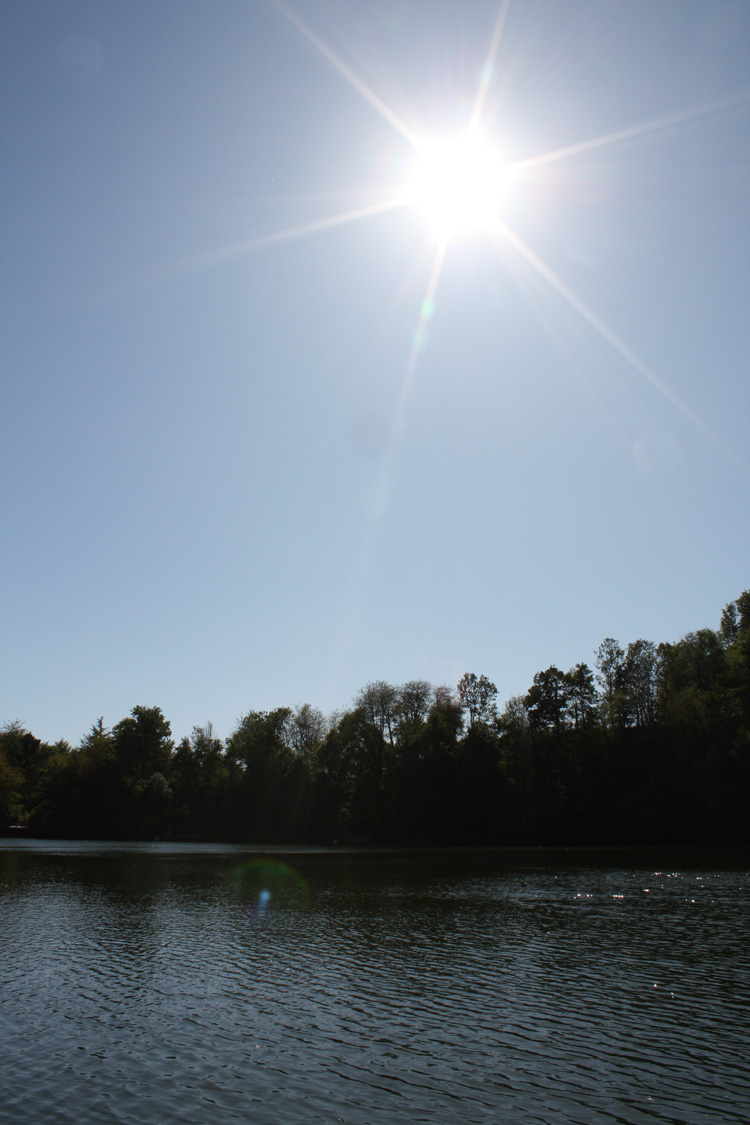
Noonday sun at Quarry Bank Fishery, France. Time for mad dogs and Englishmen to seek some shade and eat some lunch.
Regroup
Having cooked lunch, Shaun, Tim and I sat around the picnic table next to the lodge and, while eating, discussed the way forward in our attempt to catch Quarry Bank’s big carp.
“The fish are feeding,” said Shaun. “We’re seeing plenty of activity, with carp moving in Tim’s swim just before midnight, out in the middle of the lake during the night, then in the corner by Fennel’s swim at first light. But they know something is up.”
“How so?” I enquired.
“These fish,” replied Shaun, “are rarely fished for, so they’re accustomed to a routine where no anglers are present. All wild creatures are aware of when predators are present, which this week is us. My guess, from what I’m seeing, is that they know that Neil isn’t about as usual. They're not tame, but these fish are conditioned by what he has provided for them at this special place.”
“What d’ya mean?” asked Tim.
“Well, we’ve seen that the main feeding spell is mid-late morning. My guess is that this is when Neil would normally go out in the boat and top up their natural diet. They’re on the lookout for food at this time and, probably, are looking for pellets. Secondly, the lake is going really quiet during the afternoon. This isn’t surprising given how hot it is, but the water at the bottom of the quarry should be dark and cool enough for the fish to continue feeding. I’d imagine that Neil would normally run his aerators in the afternoon, so not turning them on might have spooked the fish.”
“Good thinking, Shaun,” I said. “We have to consider what is ‘natural’ for these fish. If their day normally involves Neil going out in the boat, throwing pellet over the side, then switching on the pumps, then we should ask him to do the same and see if it puts the carp at ease.”
“That’s only half the plan, though,” said Tim. “We’ll need to consider watercraft. Fennel and I have been watching a big carp crashing over on the far side of the lake, so we might have a shoal of fish there that we’ve not accessed.”
“And we might need to consider our bait presentation,” I said. “If they’re looking for fishmeal pellet, then a fishmeal boilie surrounded by that pellet would be appropriate. It might explain why I caught my fish on a Spicy Spirulina rather than the other types of boilie, though one would have thought that a Magnum White bait, being so visible, would have attracted the fish.”
“I doubt there’s much light down there at all,” said Shaun, “so the food signal from the bait will be important.”
“I might give those Pimple Pops a go,” I said, as a fluorescent blob on each bait might add to its attractiveness.”
“That’s why they’re there,” said Shaun.
“All about confidence,” said Tim.
“So we have a plan, then,” said Shaun. “We’ll ask Neil to go out in the boat as usual, turn on the aerators, provide us with pellet, and then fish in the Steps swim on the far side of the lake. Fennel will lengthen the hairs on his rigs, Tim will loosen the clutches on his reels, and I’ll use all three rods for carp. We’ll then fish over pellet, while keeping our eyes open for signs of movement and our fingers crossed that the plan will work now that the moon is waning.”
“That’s a good plan,” I said.
“A team plan,” said Tim.
“So, then,” said Shaun, “as we’re in agreement, I’ll go and share the plan with Neil while you guys do the washing up…”
Back at it
With Tim and I having completed our domestic chores, we walked back towards the lake. Shaun and Neil were talking by the pagoda and, next to them, were three large buckets.
“Pellet’s sorted,” said Shaun.
“Put about a kilo around each hookbait,” said Neil. “The carp are used to finding a good sprinkling of pellets in each spot.”
We thanked Neil and then, as we turned towards the lake, saw that the water surface was sparkling like champagne.
“Diffusers are on,” said Neil. “They’re sending millions of tiny bubbles up through the water. The fish love them.”
As if on queue, three carp started rolling and leaping next to the fizzing in the middle of the lake.
“The big aerator will come on next. It’s a lot more dramatic, but it really turns over and oxygenates the water.” Sure enough, a turbulent boil began to build in the water in front of the pagoda and erupted in volcano-like explosions of spray.
“Secret Polaris missile, Neil?” I asked.
“Nah,” said Shaun, “That’s a catfish with wind.”
“You guys,” said Neil. “I hope you’ll be better behaved when we go out in my boat? Captain’s orders!”
“Yes, chaps,” said Tim. “You’d better get a move on. I’ll be baiting up soon, and I might be aiming my catapult in your direction.” He then picked up his bucket of bait and walked back to his swim, while Shaun and I rubbed our hands at the prospect of going ‘Swallows and Amazons’ at Quarry Bank. As Kenneth Grahame said in Wind in the Willows, “There is nothing – absolutely nothing – half so much worth doing as simply messing about in boats.”
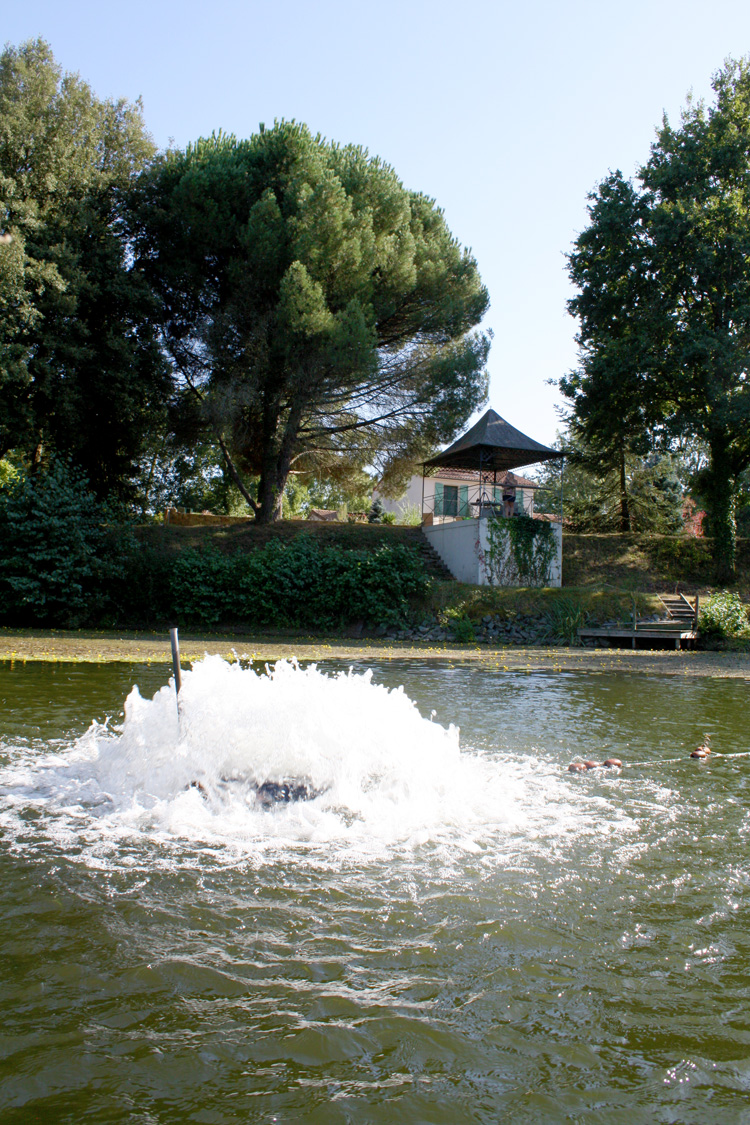
The catfish had a tendency to trump rather violently at Quarry Bank.
Afloat
Shaun and I grabbed our cameras and headed down to the boat. He and I got in and sat at the front while Neil stood behind us in the boat controlling its electric motor. Soon we were silently inching forward, out onto the lake and doing our best not to think of the great depth of water beneath us.
Being on the water, rather than next to it, gave us a fishes’ eye view of the lake. Quarry Bank seemed much bigger and more dramatic; the cliffs seemed taller and domineering, yet it was evident that some of the rock was quite loose and could slide free in the next frost. I wondered how terrifying it must have been for the quarrymen working at the base of the cliff, looking up at the towering walls of stone, knowing that they could collapse on top of them at any moment. Yet I didn’t feel scared. I was wearing a lifejacket, which, as everyone knows, makes us impervious to the crushing effect of landslides and falling rock.
Actually, I mostly felt awestruck by the lake. It was once a manmade crater, a frightful scar on the landscape, yet now, with the addition of water and trees, it had enhanced the landscape. It proved that Nature will always reclaim her own. There was so much wildlife around us, way more – I would imagine – than when the quarry was a field prior to being excavated.
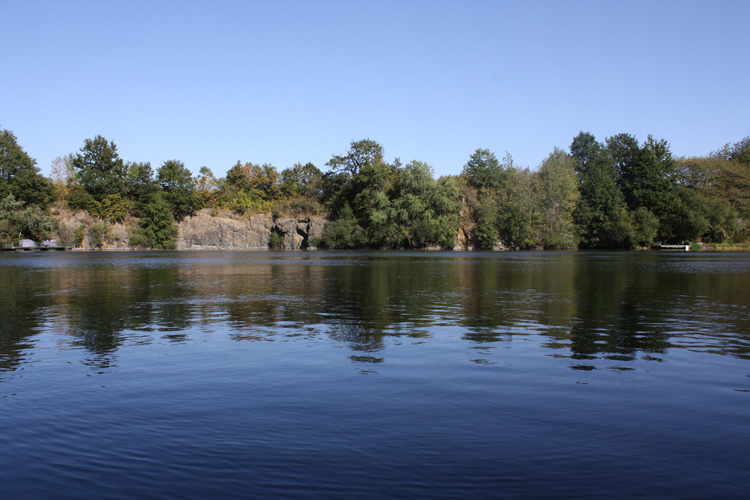
Cliffs above, and a lot of water below. So many depths to fathom.
Being in the boat, knowingly going to places where man could not normally tread, made me realise that for wildlife to flourish, it needs us to get out of the way and stop interfering with it. The vertical cliffs at Quarry Bank had enabled this to happen. There was every likelihood that Neil had been the first person to climb them since they were formed. Not just in the near-sixty years since the quarry had been a lake, but in its near-ninety year history. And although they were mostly exposed rock with very little soil, they were covered in trees, shrubs and climbing plants. Nature was very much ‘doing her thing’. So although I might have expected to be gazing down into the water, I spent nearly all my time looking up at the cliffs. Those thirty feet of rock contained more wildlife than if they’d been laid out flat for all to trample on.
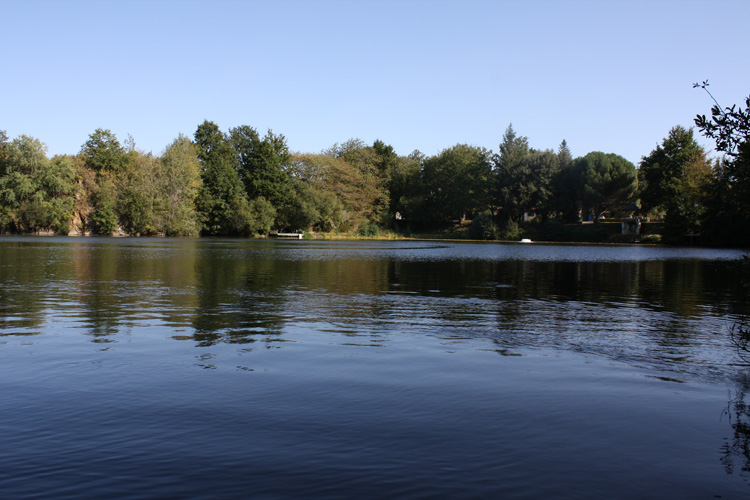
Floating over the corner where the carp were showing each morning.
Seeing the cliffs up close, noting the occasional scree fall and fallen branch, made me appreciate that Nature isn’t as delicate and retiring as we might think. She has a strong might, always seeking to heal a scar on her otherwise beautiful face, and hits back hard from a punch that caused a crater the size of that at Quarry Bank. She was doing her best to not just put a green plaster over the wound, but erase the scar altogether by filling it in. This is the fate of most lakes, especially those formed on streamlines where sediment deposits and reed encroachment eventually reclaim the lake as land. Fortunately for the quarry pool, it was spring fed and thus not subject to such extreme siltation. But where one pool ages almost imperceptibly, Quarry Bank’s fate was rather more dramatic.
“See that cliff over there?” said Neil as he pointed to an exposed sheet of rock to the right of the steps swim. “That whole rock face broke free and slid into the water. It sounded like someone driving a lorry into the lake. And see those gaps in the trees? That’s where trees fell in winter storms. I had to go out in the boat and cut them up, then drag them ashore.”
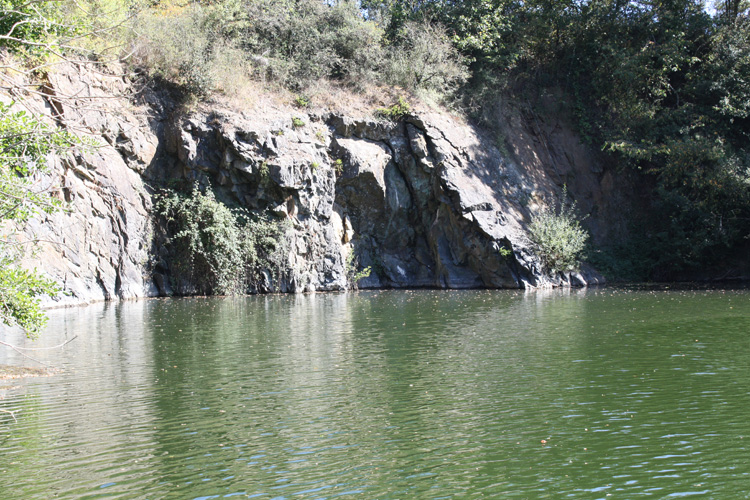
Site of the cliff-fall, evidence of Nature seeking to heal her scars.
Like nearly all fishery owners, Neil was constantly working with and against Nature to keep the quarry pool as a lake and not a tangled and unfishable wilderness. Doing so requires a balance of patience and strength. Do too much and the lake looks manicured and artificial, do too little and it looks neglected. Somewhere in the middle will usually give you a Sunday afternoon off to rest your weary limbs while everything grows back again. As a fishery or estate manager, Monday mornings are always accompanied by a sense of déjà vu.
“I’ve kept on top of it,” said Neil. “The only thing I can’t do is dive down into the lake with a hammer and chisel to smooth out all the subsurface cliffs, ledges and rocks.”
“Could always drain it,” said Shaun, “with a bit of hosepipe attached to a foot pump. Then Lin could keep pumping while you dash out into the quarry with a lump hammer. Shouldn’t take more than a day…”
“Maybe,” I said, “while you’re down there, you could run a hoover over the bottom? There’s sure to be a few twigs and leaves that need clearing up.”
“Hey, you two,” said Neil as he turned off the boat’s motor, “do you want to get back ashore or what?”
“Sorry Neil,” I said, “we were only joking. We wouldn’t possibly expect you to do all that.”
“Besides,” said Shaun, “just think of your water bill when you topped it all back up again.”
“Tap water's not cheap,” I stated, “but these fish are used to spring water.”
“Good point,” said Neil, “I’ll use bottled water. I hear that Evian is quite good.”
With the three of us chuckling our way around the lake, we completed our tour and returned to dry land. Shaun and I collected our buckets of pellet and walked back to our swims. As we did, we heard Neil call to Lin who was relaxing in the pagoda. “Lin,” he yelled, “where’s the foot pump? I’ve got a job for you to do.”
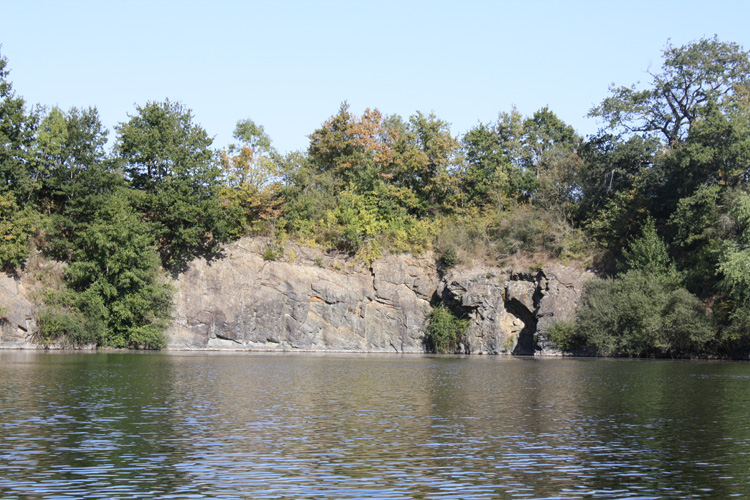
They look tame from the boat, but those cliffs are 30ft high.
Afternoon fishing
Standing in my swim, holding my bucket of newfound hope and sensing that we were halfway through our week, I felt rather like I was walking back onto a football pitch for the second half of a match. We’d had our sliced oranges and escaped the ‘towel slapping’ japes of the team prankster, had our shin pads in place for the next bout of kicking, and our laces were tied so we could run with the ball should it come our way. So while we knew we weren’t facing an open goal, we’d maximised our chances of scoring.
I cast out all three rods, two to the left as before but brought the right hand rod closer in to the bank, thinking that the carp might be accustomed to plucking things from the underwater cliff. I used Spicy Spirulina boilies on the left rods, over which I catapulted two handfuls of boilies and several pouchfuls of pellet, and on the right-hand rod I used 20mm Rajha Spice boilies cut in half (thinking that if they weren’t round, they wouldn’t roll down the cliff – even though the reality was that there was no slope, only a vertical cliff). To each bait was added a fluorescent yellow Pimple Pop.
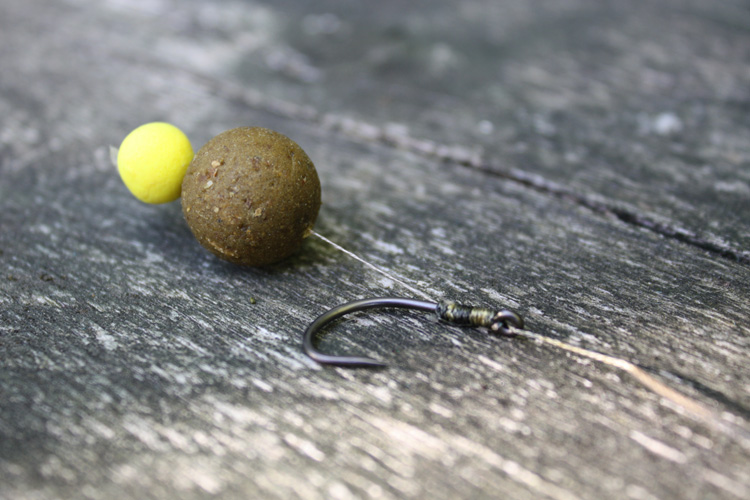
Hopefully a winning formula: Quest Baits' Spicy Spirulina boilie with fluorescent yellow 'pimple pop' pop-up on top.
I got bites almost straight away on the right hand rod. The first few had me jumping up in excitement, but when they didn’t materialise into a steady run I realised that they were just roach playing with the bait. After an hour of “de-doop-de-doop” bleeping on my indicators, I decided to reel in the right-hand rod and cast it further out into the 30ft gully. Then I put a kilo of pellets around it and thought, “Well, if nothing else, I’ve built a wall of pellet that will stop the carp in their tracks.”
At around 5pm, the sun began to dip and shadows lengthened across the lake. The scorching heat began to subside and my corner of the lake began to look really ‘fishy’. Clusters of bubbles were appearing over my baited spots and I began thinking that Shaun’s analysis and game plan was right.
Twenty minutes later, the alarm of my left rod sounded. I looked up to see the handle of my Mitchell 300 spinning and the rod tip pulled down and to the left. I jumped up, grabbed the rod, cupped the reel with my left hand, then leant into the fish. It felt really, really heavy: a solid pounding on the rod that jarred my shoulder and made me shuffle my feet to get a better foothold. The fish chugged along, parallel to the cliff, hugging the bottom. I gave line when needed, but mostly kept a tight line, kiting the fish upwards and away from the rocks. Slowly I was able to ease it back towards me, reeling as quickly as the little reel would allow. And then, without a jolt or grate, the line fell slack. Not a limp weightlessness felt when the line breaks, rather the loose weight of a lead on the end and nothing else. I reeled quickly and saw the lead and bait appear on the surface. I swung them in to my hand, checked the hook (which was fine) and then cast out again without so much of a curse or despondent shaking of my head. But I was gutted. Yet another hook pull. I figured it was either because I hadn’t lengthened the hair when I added the Pimple Pop, or that the barbless hook fell out because I couldn’t maintain tension on the fish when it swam towards me. “Blummin’ reel,” I said under my breath, though it was almost certainly because of a poor hook-hold. Whatever the reason for the loss, I’d just lost the heaviest fish I’d ever hooked.
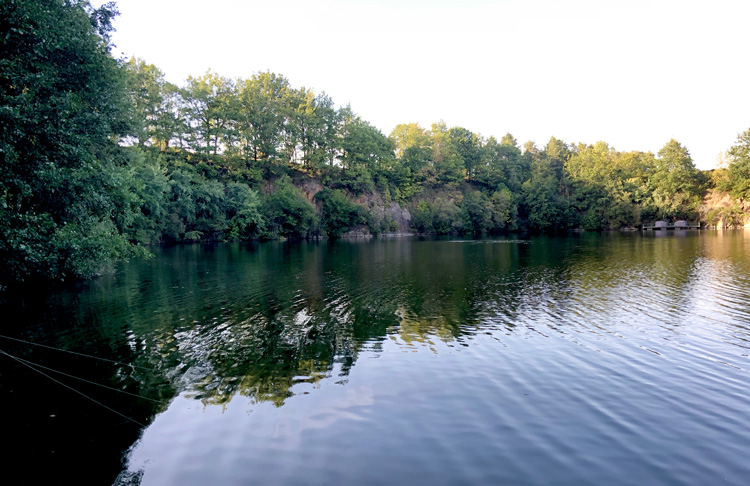
The sun lowers and shadows form in my corner of the lake, triggering the fish to feed.
You either got it or you ain’t
There’s no quick or easy route to catching a big fish. You have to learn the water, find the features and ‘read its mood’ to understand how weather conditions, light levels or time of year will affect the fish. And then you have to work hard at watching the water and ensuring your baits are in the right places. If you hook a huge fish and then loose it, as I did, then you have to learn from your mistakes and keep going regardless of how crappy you might feel about your failings. Carp fishing, by definition, is an act of perseverance more than patience. Dogged determination to never give up, even if it feels like your faith, luck, stamina or will to succeed are running low. Carp fishing is not meant to be easy. If it were, it would become predictable and boring. One has to put in the effort, the hours, the sheer bloody-minded hard graft and stubborn self-determined resilience; often sacrificing home comforts, relationships and steady employment in return for the opportunity to put your bait in front of a big carp at the precise time, and in the exact location, when it chooses to feed. It’s an accumulation of impossible odds, a slowly building drama, a courtship and adventure that often take years to mature. Hence why one’s strategy to catch a big carp often accounts for several seasons and many hundreds of hours of ‘campaign’ duty.
Or, of course, you could fish like Neil.
Having agreed to fish the water in front of the Steps swim, Neil casually turned up at 6pm, cast in, lit a cigarette, put his feet up, and within thirty minutes had a 36lb mirror carp in the net.
“Is he having a laugh?” said Tim on WhatsApp. “Has he trained that fish to come to his whistle or something?”
“I reckon he keeps it on a leash,” I replied, “to reel in when needed.”
“Nah,” said Shaun, “He’s got a fish magnet in his pocket.”
Neil’s result was beyond impressive. His success was a barely comprehensible achievement that thoroughly took the pee. But we didn’t hold it against him. As Tim said, “We put him onto that fish. We’ve been watching it leaping over there for three days, so really he was just benefitting from our outstandingly advanced and highly attuned observation skills.” “And laziness,” I replied. “It’s a long walk to the far end of the lake. If we’d gone there, we might have spilled our glasses of wine.”
An extra bit of effort and a steady hand are useful traits when it comes to fishing for big carp. But some guys really do have all the luck. As 1970s pin-up Lynsey de Paul sang, “You either got it or you ain’t.” Quality angling; that’s the one thing you can’t fake. So Neil got himself a new theme tune and, with it, a very cool ‘razamatazz’ groove that played on my phone as he swaggered up the 31 steps to announce the capture of his fish.
“Shoo-doo-be-doo-dah” indeed. Neil was The Man.
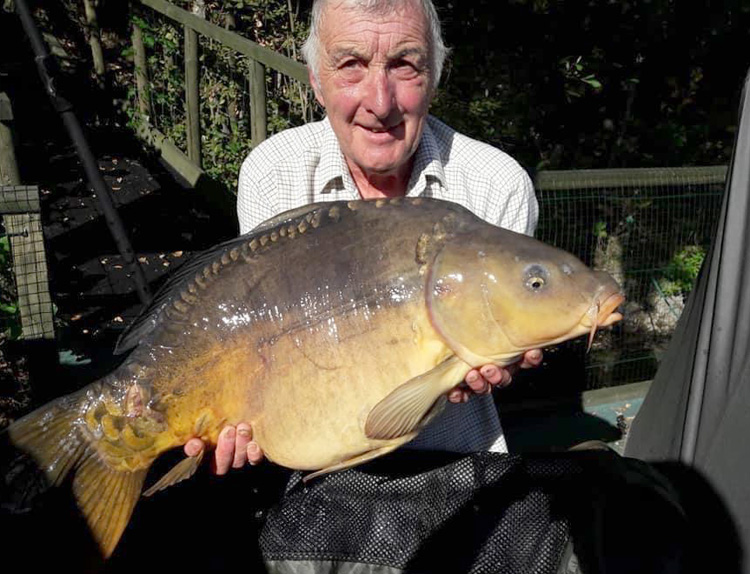
As wide as it was long, even Neil's fish was modest about its achievements.
Eventide
Under normal circumstances, Shaun, Tim and I would have congratulated Neil by toasting his success with a few drinks. But we couldn’t do that. Not with our new game plan. We had renewed focus, an obligation to be on our rods and a desire to be connected to a humongous carp. Fuelled by Neil’s fish, we had a barely containable sense of excitement that ‘it could happen’ for us at any second. So, no, we would not toast Neil’s success. He would have to celebrate on his own, the jammy beggar.
With one fish on the bank and one lost within an hour of each other, we knew that our new plan was working. The fish had responded well to the aerators, pump and boat. And they sure liked pellet. “Bait it, and they will come,” I said as I watched huge patches of bubbles erupting from my baited areas.
The carp in my swim continued to feed, but without me getting any bites. I wondered whether they were doing their usual trick of sucking in my hookbait and then spitting it out with all the bits of twig and grit that accompanied each mouthful. In other words, I wondered whether my rigs were working properly and whether, for the second time that trip, I should have complied with Shaun’s instruction and lengthened the hair on the hook. But with six or seven carp feeding confidently over my bait, I decided not to disturb them by reeling in and casting again. Instead I retired to my bivvy to write up a day’s notes, keen to capture the events of the day and write something philosophical about how ‘eventide’ marked the changing tide in our fortunes.
I must have nodded off because, at around 10.30pm, I was startled awake by the sound of an alarm screaming into action. It was one of those super-fast single-tone “beeeeeeeeeeeeeeeeeeeeee” runs that never seems to catch its breath long enough to add the “p” to its beep. I shot up and ran towards my rods, only to see that none of the alarms were triggered. I took a deep breath, then realised that the sound was coming from Tim’s swim. The alarm stopped suddenly, then I heard Tim say, “Ahhh, it’s solid.” By the time I’d run to his aid, I could see Tim holding aloft his rod, which was in a static curve. “It’s solid, Fennel. Snagged me almost straight away on the drop-off on the far side of the road. I can’t believe it, I’ve been done again!” Tim and I agreed that the best thing to do was slacken the line and put the rod back into the rest to see if the fish would free itself. But both of us knew that, as we were using barbless hooks, the fish had probably already gone. I returned to my swim, thinking that the tide might not be as even as I’d thought.
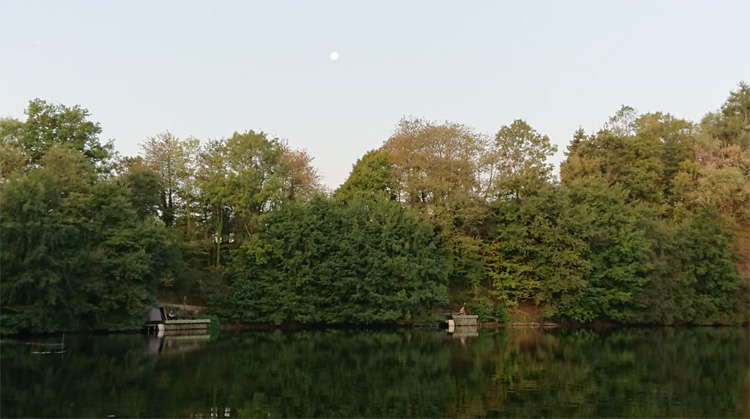
The Harvest Moon rises above the lake, focusing one's attention between Tim's swim and mine.
Night
By midnight, a strong and gusty breeze had built, coming in from the north. I had to zip down the bivvy door and tuck myself deeply into my sleeping bag, pulling it tightly over my head to stay warm. The cold was keeping me awake longer than I’d have liked, but all through the shivering I felt like I was somehow enduring the challenges to stay focused on catching a big carp. “C’mon, carp,” I said through chattering teeth, “do your thing.” Sadly they did, characteristically ignoring my offerings and allowing me a few hours of chilled and slightly uncomfortable sleep.
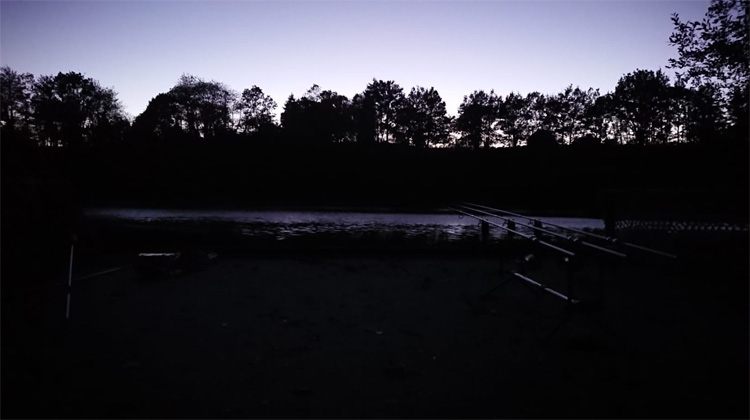
The midnight pool, as viewed from Shaun's swim.
Morning
I woke at 4am to the sound of dogs barking at the local kennel. Then I heard several big carp crashing in the middle of the lake. I got out of my sleeping bag and tiptoed out onto the decking of my swim to look for the carp, which I hoped to see in the last glow of moonlight. Eventually I saw them, leaping and rolling over Shaun’s bait and towards the cliff beneath the kestrels’ nest. Some fish made deep “walloooomps” as they landed on the water. The crashing lasted for about half an hour, then all went quiet. I remained sitting on my chair, rubbing my legs to keep them warm, for nearly three hours – all the time hoping that an alarm would sound. But the only thing to break the quiet was the “cowke-a-cruuuuw” of a sore-throated cockerel at 7.15am, just as the first glow of day was bathing the horizon.
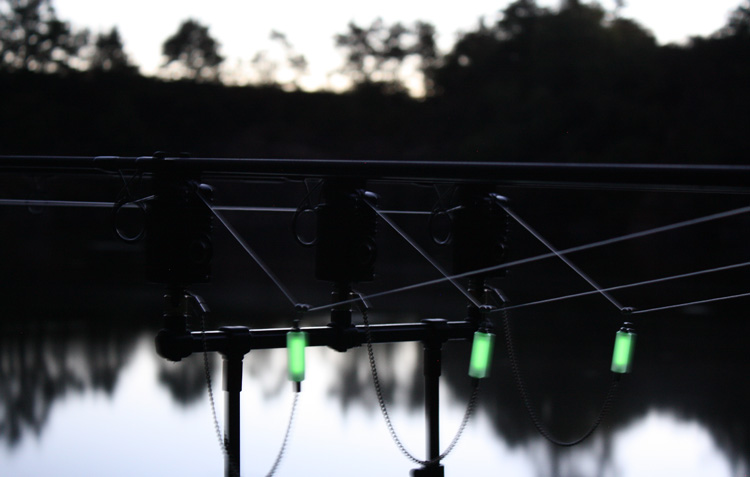
Bobbin-glow at first light. Welcoming the morning at Quarry Bank Fishery, France
By 7.30am, the dawn chorus was in full song, with wrens clicking, robins singing, crows cackling, buzzards mewing, kestrels screeching and a friendly blue tit saying ‘top a da morning’ to me with a very cheerful if a little Irish-sounding “hee-hoo-tee-tee”.
The water in front of my swim was also alive, with roach and rudd feeding on the surface. I couldn’t see what they were feeding on, so I concluded that it was either a new squadron of midges seeking to break free from the water and take off in attack formation, or the remains of last night’s sedges that had laid their eggs in the water and then died. Either way, the fish were enjoying their breakfast.
My gaze was soon distracted from the fish when I heard Shaun shout, “I’m in!” I hadn’t heard his bite alarm, nor was I aware that he knew I was up, but as I looked up I could see him kneeling down on the decking and giving some frightful side strain to a fish that was attempting to kite to his right. The line was stretching far out into the lake, reminding me of when a reservoir trout fisher hooks a fish at range on a dry fly. Yet Shaun’s fish was running deep, so had apparently made good ground on him.
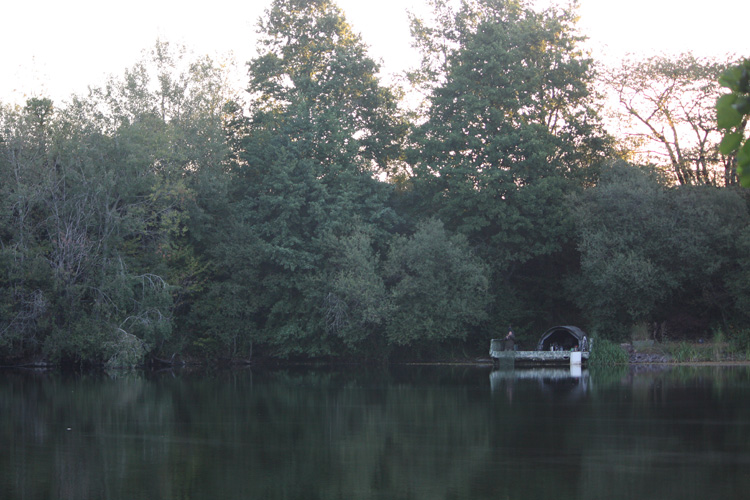
"I'm in!" shouted Shaun.
Shaun remained kneeled while pumping the fish steadily towards him. I fetched my camera and zoom lens to take some shots of him playing the fish. When doing so, I could see why his line had such an acute angle: Shaun was playing the fish beneath overhanging trees to his right, thus his rod tip was low to the water.
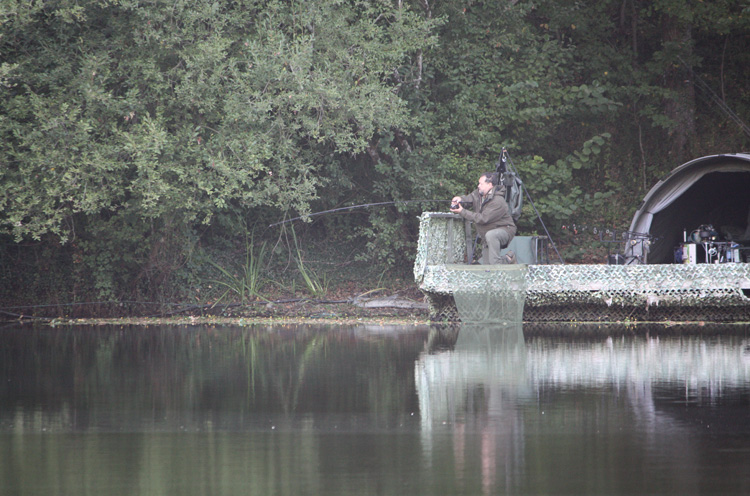
Shaun gives the fish side strain to steer it away from the overhanging trees.
Gradually the carp drew closer and, following a last-minute tussle beneath the rod tip, was safely netted. I saw Shaun lean back and look to the sky, knowing that he was probably saying an enthused but relieved “Yeeeees!” at finally catching a carp.
“I’ll come round with the camera,” I shouted, then reeled in my lines and walked quickly towards his swim.
Passing Tim’s swim, I could hear him snoring and saw that the rod on which he’d hooked his carp was now reeled in and propped up against his bivvy, and the bobbins on his other rods were level. “At least he’s had a good night’s sleep,” I thought to myself as I continued walking.
By the time I arrived in Shaun’s swim, he had all his weighing and photography gear set up ready to record the fish. The carp was safely in a retention sling, which allowed me time to shake Shaun’s hand and catch up on the story of how he caught it.
“Had it from over there,” said Shaun as he pointed to an overhanging willow about forty yards away, “and on the ’pin, too.”
“How on earth did you cast that far with a centrepin and still allow extra line for the lead to sink?” I replied.
“Well, first off, it’s only about 18ft deep there,” replied Shaun, modestly, “but I’ve got a little trick that’s possible when fishing with thick line and a nice smooth area like this decking. I walk to the far corner of the swim, holding my rod and reel, and then peel off line so that it coils in big loops on the ground to my left, then continue doing this as I move forward. By the time I reach my casting spot, I’ll have pulled off about fifty yards of line which can be cast as though from a fixed spool reel. Because I’ve laid all the line out, and there’s nothing for it to snag on, it doesn’t tangle; so I can fish at quite a distance with a centrepin.”
“Sneaky!” I said, while making a mental note to use this technique to cast both of my centrepin rods onto the hotspot in the corner of my swim.
“I’d decided to reposition that rod close in to the bank,” said Shaun, “after having lots of savage line bites through the night. It’s not been fishing all that long, but it intercepted the fish as it came patrolling round the corner under those trees.”
“So,” I replied, “you stalked it with an effortless, pinpoint, 40 yard cast on your centrepin, that landed in a three foot gap under the trees, and was then feathered down to the exact spot on the bottom?”
“No,” said Shaun, “the fish wasn’t stalked. I hadn’t seen it, only figured out that it would be patrolling there. To be honest, I’ve put more effort into fishing the spot in the middle, in line with four white-stemmed trees on the far bank. But the carp sometimes tell us where they are, and those liners revealed that the fish were moving close in.”
“The carp were out in the middle as well,” I said, “I saw and heard them in the night. But you did the right thing in casting that rod over there. ‘Cos y’ caught one!”
Shaun and I grinned, then Shaun said, “better let you see it, then.” He walked to the edge of the staging, to where the sling was floating, then removed it from the water. It seemed to be filled with a huge carp, which kicked and sent spray flying across the decking, but Shaun assured me, “It’s not that big.”
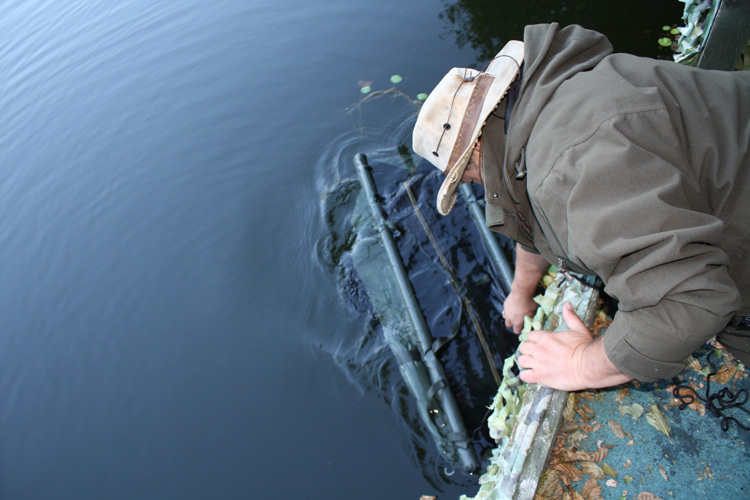
The sling was bulging with a very powerful carp.
Laying the carp down gently into the unhooking cradle, Shaun parted the mesh to reveal a solid-looking mirror carp that had a defining ‘moonscale’ on its right flank. If I were into naming carp (which I’m not), the scale would inevitably enable it to be recognised in the future. But to me it was ‘Shaun’s Fish’, an impressive looking carp that seemed bigger than it’s weight. The weighing scales, when we lifted the carp onto them, stated 26lb exactly.
“Told you,” said Shaun, “it's not that big.”
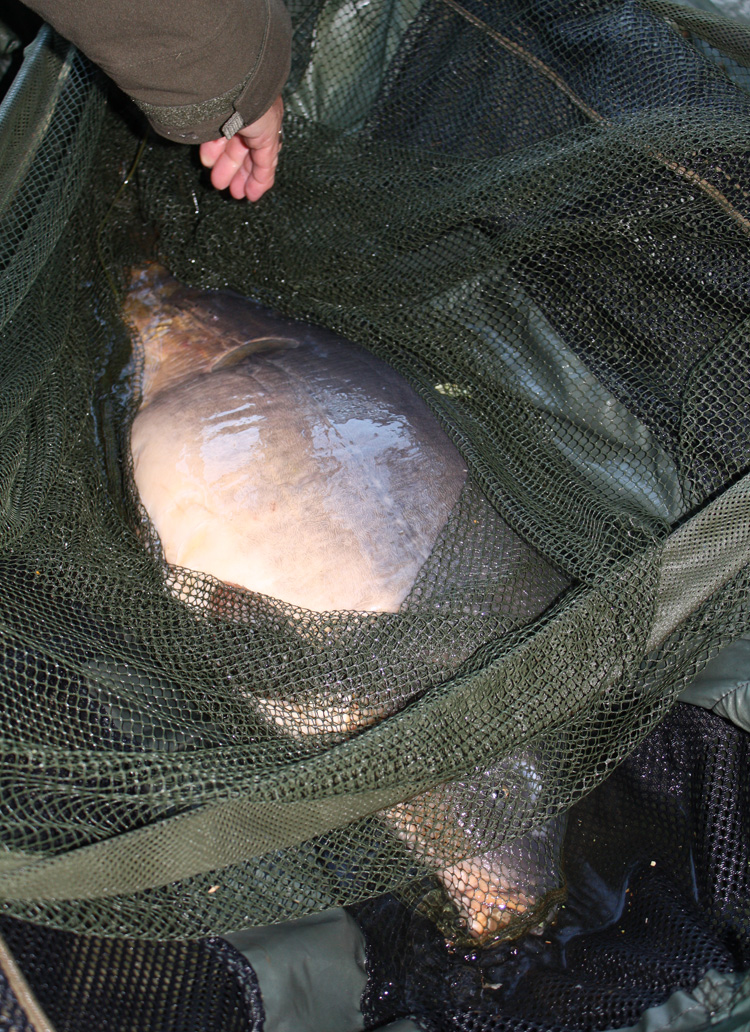
First glimpse of the carp and its distinctive 'moonscale' flank.
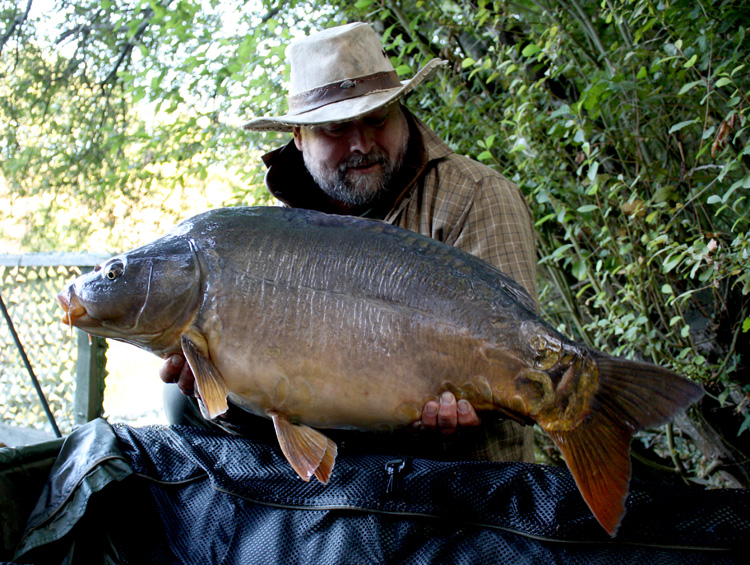
At 26lb exactly, Shaun's Quarry Bank carp was "not that big" for the water.
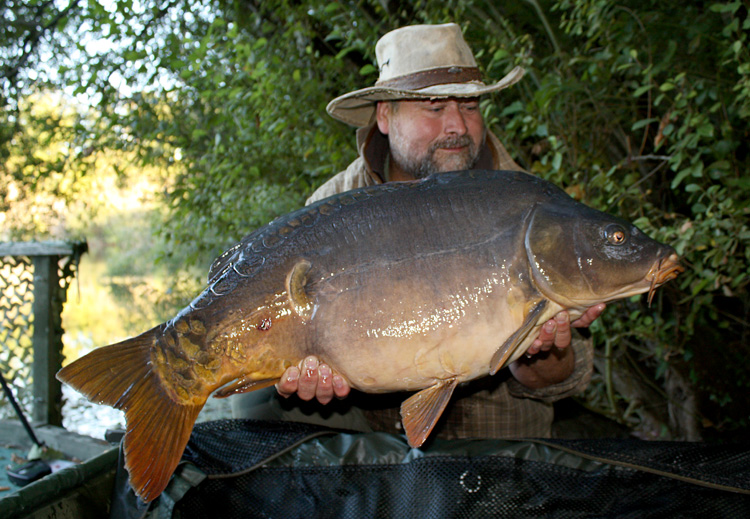
"Moonscale" or simply "Shaun's Fish", the carp was a hard-won prize that proved that watercraft and a game plan can work wonders.
Turning the hourglass
Shaun's fish was a carp caught in difficult conditions, using great skill, and as the result of a team plan well executed (and aided by some excellent watercraft). It proved that when an angler pieces everything together, he or she can get the upper hand.
Shaun carried his carp back to the water and returned it. He looked up and across the lake. There was Tim, standing bleary-eyed in his swim, with his arms far apart as he gave a big stretch to welcome in the morning.
“Just got to get Tim catching, now,” said Shaun. “He’s had his chances, but no luck.”
“Luck in angling is rather like the sand in an hourglass,” I replied, “it pours away but collects. You just have to ‘turn things around’ to change your fortune. We have a game plan, but, as with those sands, do we have enough time?”
“48 hours,” replied Shaun, “before we reel in and return to England. That’s longer than the average session, so Tim has every chance of catching. And we’re just getting going. There’s a carp in here with his name on it, that’s for sure. And by the way he’s going, it will probably be the biggest fish in the lake.”
“The one worth waiting for,” I replied. “Whether it be this trip or the next, he’ll get his fish.”
“Exactly,” said Shaun. “If you’re going to wait, it might as well be for the big one.”
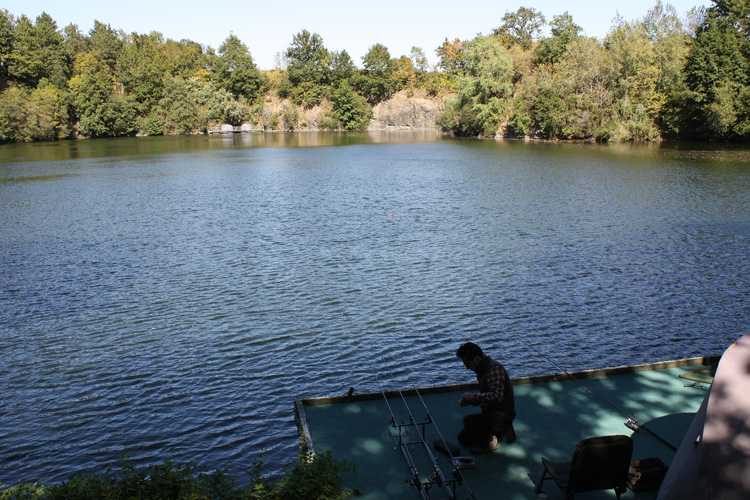
Out there, somewhere, is a huge carp, challenging Tim to catch it.
In Part 11, the big carp of Quarry Bank begin to stir.
Quarry Bank Fishery is a 5-acre water in southwest France, about a two-hour drive from Limoges airport. It is set within 14 acres of private grounds, which are sensitively managed for their wildlife interest. This makes it a haven for both anglers and fish. The fishery is available for exclusive bookings only, for up to five anglers.



